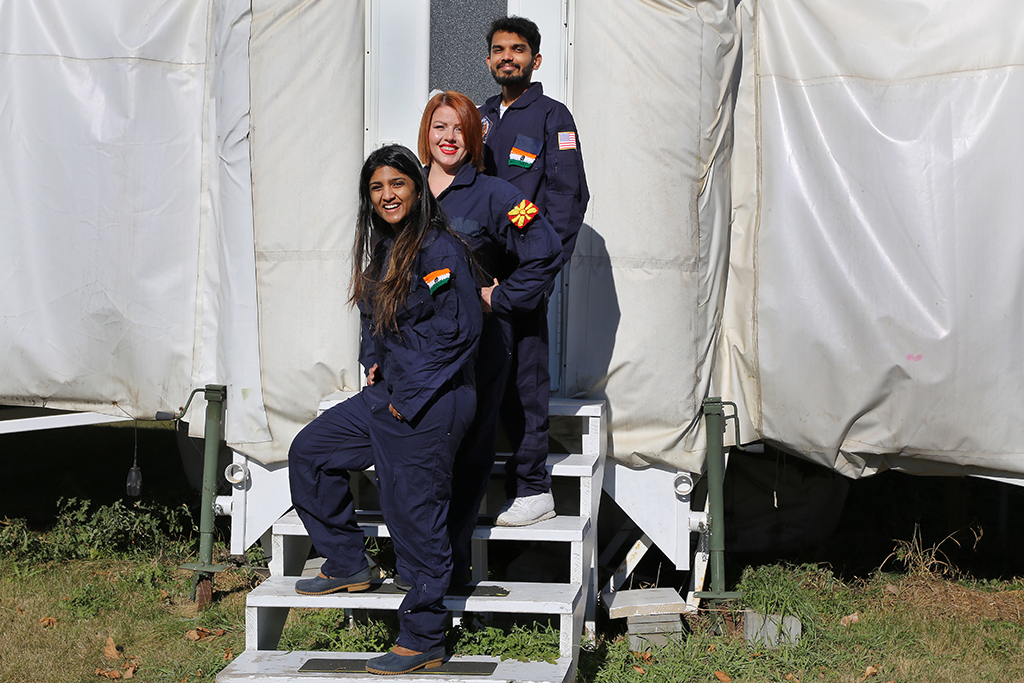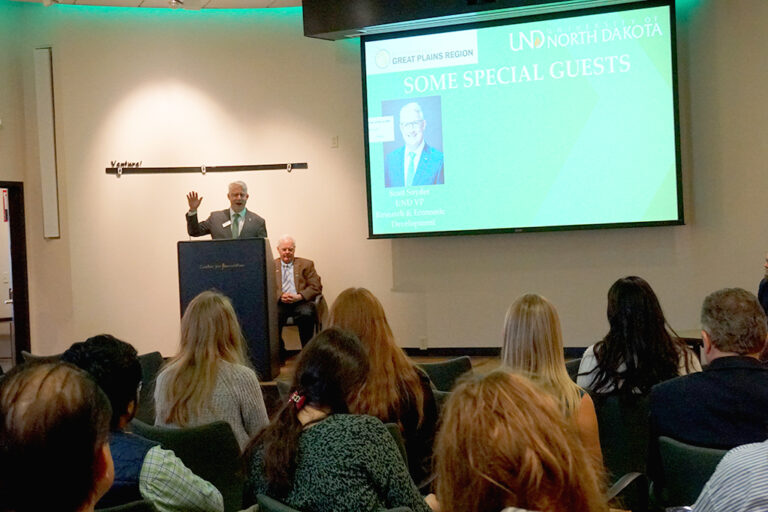On the ground at UND but 63.4 million miles away
Three graduate students begin 14th mission in UND Space Studies’ Inflatable Lunar-Mars Analog Habitat

The temperature was a chilly 19 degrees on Monday, Oct. 17, the day the crew of three UND “astronauts” began the 14th mission in the NASA-funded Inflatable Lunar-Mars Analog Habitat (ILMAH), west of Interstate 29.
That’s not as cold as the temperature on Mars, which, according to the National Weather Service, averages a frigid 81 degrees below zero (And why does the National Weather Service even track the temperature on Mars anyway?). The grad students will be spending up to 21 days inside the Habitat doing research for an extended Mars mission.
“Will I see you in class on Friday?” shouted a student to laughter, shortly before the astronauts entered the ILMAH. The student was there, along with about a dozen other students and UND faculty members, to watch the “ingress ceremony,” an event that celebrates closing the door of the habitat for the duration of the mission.
“Probably not!” answered Tarun Bandemegala, commander of the mission, though he did say he’d keep in contact with people on “Earth” through email.
The habitat is operated by the UND Department of Space Studies in the John D. Odegard School of Aerospace Sciences. Joining Bandemegala are Pranika Gupta, who is acting as flight engineer, and Martina Dimoska, science officer. Dimoska is an international student from Macedonia, participating in a study at UND. The trio will focus on a variety of different experiments, ranging from drone flights to field testing the enhanced version of the UND NDX2-AT extravehicular activity suit—perhaps better known as a spacesuit to non-astronaut types.
And they will be doing it all from the self-contained environment of the habitat, UND Space Studies’ multi-compartment structure used to test technology and run experiments about extended stays on Mars or the moon.
Asked just moments before the astronauts entered the habitat, they said they felt “happy” and “excited” to be involved in the mission. They will remain in the enclosure for a maximum of 21 days, or as long as the weather will permit the mission to continue.
“I think it’s going to be a smooth mission and we’re going to have a lot of research ready,” said Dimoska.
The profile of the 14th mission in the ILMAH is extensive. Bandemegala and crew will make excursions from the structure in the attached rover, conduct an exercise study developed by Simon Fraiser University in partnership with the Canadian Space Agency, NASA and UND, and do research in the habitat’s plant module, among other scientific and personal projects.
As part of a special research project, the astronauts will also simulate drone flights that could happen on the surface of Mars, and from the rover they will then deploy a real drone to fly near the structure. And they’ll be doing it while hooked up to an electroencephalogram to record their brain activity.
NASA’s Perseverance rover on Mars recently deployed a small helicopter, Ingenuity, to explore the planet from above. Following from that, data collected from the EEG project will help researchers understand if astronauts can pilot drones safely in the simulated conditions at ILMAH, a necessary step to them piloting drones in space or on the surface of a planet like Mars.
“That way we can actually measure cognitive capabilities of astronauts and how we can improve them for an actual spaceflight,” Bandemegala said.
The astronauts will, of course, maintain radio contact with Mission Control (located at UND), and they will be doing that with an appropriate time lag of 20 minutes each way, to account for the 63.4-million-mile distance between Earth and Mars. To do that, they will use an online system called ECHO, developed by Space Studies Ph.D. student Dario Schor. Should Mission Control need to contact Bandemegala, Gupta or Dimoska, they’ll have to wait 40 minutes for their reply. The same goes for the astronauts.
Despite the time lag in communication, Dimoska said she is confident they will carry out their tasks well.
“We have a good crew, we have a good bond,” she said. “So far, everything is going smoothly. We know how to work together, and we are really excited for the research we are going to do.”
The crew is hoping to complete the full 21-day-mission, though as fall gives way to winter the weather may play a role in how long the mission can last. But one thing is clear: It’ll be a lot colder when they come out of the habitat than when they went in.



